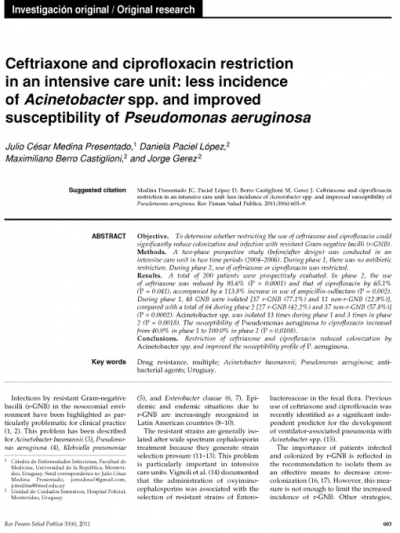JULIO CÉSAR MEDINA PRESENTADO, DANIELA PACIEL LÓPEZ, MAXIMILIANO BERRO CASTIGLIONI, AND JORGE GEREZ
Abstract
Objective. To determine whether restricting the use of ceftriaxone and ciprofloxacin could significantly reduce colonization and infection with resistant Gram-negative bacilli (r-GNB). Methods. A two-phase prospective study (before/after design) was conducted in an intensive care unit in two time periods (2004–2006). During phase 1, there was no antibiotic restriction. During phase 2, use of ceftriaxone or ciprofloxacin was restricted. Results. A total of 200 patients were prospectively evaluated. In phase 2, the use of ceftriaxone was reduced by 93.6% (P = 0.0001) and that of ciprofloxacin by 65.1% (P = 0.041), accompanied by a 113.8% increase in use of ampicillin-sulbactam (P = 0.002). During phase 1, 48 GNB were isolated [37 r-GNB (77.1%) and 11 non-r-GNB (22.9%)], compared with a total of 64 during phase 2 [27 r-GNB (42.2%) and 37 non-r-GNB (57.8%)] (P = 0.0002). Acinetobacter spp. was isolated 13 times during phase 1 and 3 times in phase 2 (P = 0.0018). The susceptibility of Pseudomonas aeruginosa to ciprofloxacin increased from 40.0% in phase 1 to 100.0% in phase 2 (P = 0.0108). Conclusions. Restriction of ceftriaxone and ciprofloxacin reduced colonization by Acinetobacter spp. and improved the susceptibility profile of P. aeruginosa.
Publicado en: Rev Panam Salud Publica 30(6), 2011




